A Halo of 7th century Japan
by
Abstract.
Patterns on halo of an Avalokitesvara (7th century) in Horyu-ji, the most distinct among halos in ancient Japan. It inherits B.C. - A.D.5th century Chinese patterns. Introduction:
Discovery
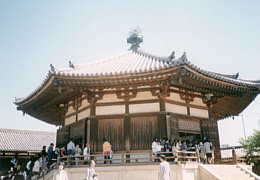
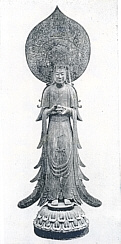 In 1879,
Kakuzo Okakura (Tensin) and Ernest Fenollosa visited the octagonal hall in Horyu-ji
monastery (Ikaruga, Nara Prefecture, Japan) as government agents. They searched and listed
the artifacts in temples and monasteries in Nara-city and outskirts.
In 1879,
Kakuzo Okakura (Tensin) and Ernest Fenollosa visited the octagonal hall in Horyu-ji
monastery (Ikaruga, Nara Prefecture, Japan) as government agents. They searched and listed
the artifacts in temples and monasteries in Nara-city and outskirts.
In the hall, a wooden sculpture of Avalokitesvara was saved and no one can see the statue
for centuries. (Really even a vice director of the monastery wrote "No one see it.
Its shape is unknown" in about AD 1238). 500 metres of white cloth rolled the statue
and saved in a large wooden altarpiece-container at the center of the hall. The container
was made in 18th century on support of one of VIP ladies in Tokugawa Government.
When the two scholars opened the container, monks escaped, since a legend said that this
monastery will collapse when the statue appears. Okakura and Fenollosa discovered the best
condition wooden life-size statue of Avalokitesvara in 7th century after removing the 500
meters cloths.
This is a legend, too. Some postulate that other scholars discovered it already.
Now, this statue is in the container. It was usually closed. In late April- early May and November that is opened. Since there is (forbidden) any lamp, appreciating isn't easy. I appreciated in May/1999. I felt it more elegant than I had felt many pictures (colour/monochrome).
Data of the statue
Kannon Bosatsu (Avalokitesvara) known as Guze-kannon. 7th century. National Treasure. Single wood block. 179.9cm height, gilt. The crown is gilt bronze openwork with semi-precious stones. Flame of the MA-NI symbol on the hands is gilt bronze. A halo is a single wood block.
Halo and its rubbing
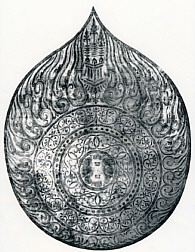 I discuss only patterns of its HALO. It is gilt wood, height 123cm, single woodblock. Any
photograph shows little of its quality, because gold was partly worn down and gold gilding
weakens the engraved lines. Only this old rubbing shows beauty of engraved lines. This
plate was reduced from a good colotype reproduction of the rubbing , Ref.1
. I feel its rubbing is very rare, perhaps unique, since it is dangerous to make
rubbing on ancient gilt wood and the monastery should not permit it. Moreover, it needs to
part the statue to make rubbing of the halo, for the halo is attached to its head with a
short shaft. Only a powered scholar with government authority or a staff of the monastery
could do it before 1930s. Ref.2 suggests Dr. Syunichi Amanuma had it.
I discuss only patterns of its HALO. It is gilt wood, height 123cm, single woodblock. Any
photograph shows little of its quality, because gold was partly worn down and gold gilding
weakens the engraved lines. Only this old rubbing shows beauty of engraved lines. This
plate was reduced from a good colotype reproduction of the rubbing , Ref.1
. I feel its rubbing is very rare, perhaps unique, since it is dangerous to make
rubbing on ancient gilt wood and the monastery should not permit it. Moreover, it needs to
part the statue to make rubbing of the halo, for the halo is attached to its head with a
short shaft. Only a powered scholar with government authority or a staff of the monastery
could do it before 1930s. Ref.2 suggests Dr. Syunichi Amanuma had it.
Pattern
Halo reliefs comprises 5 bands separated by simple positive lines:
- 1st. Center Lotus
- 2nd. 6 Dragons spiral pattern
- 3rd. Disc pattern
- 4rh. Palmets
- 5th. Flames and a tower
Lotus and 6 dragons
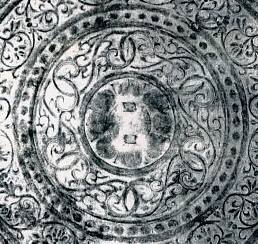
 1st lotus part is small. It was common to set a lotus at center both on
halo.
1st lotus part is small. It was common to set a lotus at center both on
halo.
2nd band is very interesting. It is spiral dragons pattern. Dragon shapes are modified to
decorative lines. 6 units are linked. Some might feel it Celtic. This inherits very old
tradition (B.C.4th century). e.g. this mirror backing design, although 4 dragons link in
this mirror. Not to say, this halo lines are more fluent than the ancient design.
This 6 dragons remind me a part of a long verse by Li-Po (AD 8th century): "6 dragons
surrounding sun" in the long verse "Schzuan-Road". A comment shows this
myth "Sun god drives a chariot with 6 dragons" should be far older than Li-Po,
at least early Han-dynasty (BC2th century), because a fragment of "I-Nang Chi"
(a book compiled in BC 2th century) shows the myth. In ancient China such Central Lotus
symbolizes the SUN. I feel that this 1st and 2nd band present "6 dragons surrounding
the sun".
Mirror and format of halo
Comparing with back ornament reliefs of ancient Chinese mirror, ancient Japanese and Chinese halo might copy Chinese mirror ornament design. This is a rubbing of B.C.4th century mirror back. Indeed mirror and halo is different, both reflect and symbolize light and same pattern could have applied. Mirrors were used in Buddhist temples before 12th century. I suppose that band-construction of halo and of mirror could share a same origin.
Palmet

 7-8th
century Japanese ancient arts often use palmets, but this is rigorous and matchless
pattern. Although palmets have Hellenistic origin, they might directly have traveled from
Korean peninsula. This Kogryo (Northern Korea) tombs (ca. A.D.600) fresco has
nearest palmets. This is one of ornaments of Nai-li 1st Tomb's near
Pyongyang. This is more similar than many Chinese stone cave ornament palmets.
7-8th
century Japanese ancient arts often use palmets, but this is rigorous and matchless
pattern. Although palmets have Hellenistic origin, they might directly have traveled from
Korean peninsula. This Kogryo (Northern Korea) tombs (ca. A.D.600) fresco has
nearest palmets. This is one of ornaments of Nai-li 1st Tomb's near
Pyongyang. This is more similar than many Chinese stone cave ornament palmets.
Contemporary similar halo
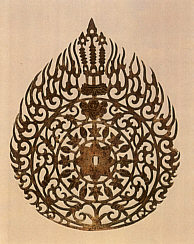 A similar halo is in Tokyo National Museum. 18.1cm. height, gilt
bronze openwork. It was stored in the Ho-ryu-ji until 1874, and transferred to The
IMPERIAL HOUSEHOLD, and now is exhibited there. (Ref.3, 4). This outer band pattern likes
the wooden halo. Shape of flames are identical. A tower with 3 ornamental top poles is,
too. The central part is different. This date is regarded as 7th century. Therefore, the
wooden halo isn't unique. At that time, such compositions might be a little (or very)
popular. This wooden halo just overcomes the other. I suppose that this might be a
model/textbook for others.
A similar halo is in Tokyo National Museum. 18.1cm. height, gilt
bronze openwork. It was stored in the Ho-ryu-ji until 1874, and transferred to The
IMPERIAL HOUSEHOLD, and now is exhibited there. (Ref.3, 4). This outer band pattern likes
the wooden halo. Shape of flames are identical. A tower with 3 ornamental top poles is,
too. The central part is different. This date is regarded as 7th century. Therefore, the
wooden halo isn't unique. At that time, such compositions might be a little (or very)
popular. This wooden halo just overcomes the other. I suppose that this might be a
model/textbook for others.
Tower and Lotus Sutra

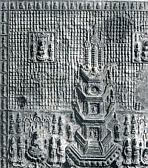 At the top of 5th band, a tower/pavilion with 3 poles is engraved. There are
another examples which has this strange tower. Right Fig. is a bronze reliefs plate in
Hase-dera temple in Nara, Japan. It was dated in AD686. Height 91cm. It is a scene in
Chapter 12th of Lotus Sutra (Suddharma Pundharika Sutra) : a very popular Buddhist bible
in far east Asia. A tower appeared from earth ,and an ancient Buddha ( who was teaching
far before the real Buddha) admires modern/real Buddha from the tower. Since this dramatic
scene is very popular among the Chinese, many tower images were made.
At the top of 5th band, a tower/pavilion with 3 poles is engraved. There are
another examples which has this strange tower. Right Fig. is a bronze reliefs plate in
Hase-dera temple in Nara, Japan. It was dated in AD686. Height 91cm. It is a scene in
Chapter 12th of Lotus Sutra (Suddharma Pundharika Sutra) : a very popular Buddhist bible
in far east Asia. A tower appeared from earth ,and an ancient Buddha ( who was teaching
far before the real Buddha) admires modern/real Buddha from the tower. Since this dramatic
scene is very popular among the Chinese, many tower images were made.
 Such tower is seen in Yung Kang Cave 6th cave(AD 5th century), too.
Such tower is seen in Yung Kang Cave 6th cave(AD 5th century), too.
Flames in Halo
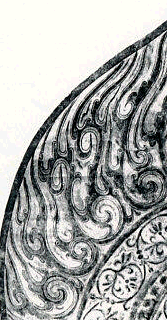 5th band represents strong and rhythmic flame pattern. Former gilt
bronze halo (above) is like it, but this is sharper.
5th band represents strong and rhythmic flame pattern. Former gilt
bronze halo (above) is like it, but this is sharper.
I show two examples of flame pattern in 5-6th century, China. This
gilt bronze statue(Fig.13) Ref. was in
Japan until 1987, and is in Taipei National Museum 44cm height. ca. AD 480-490. One of
typical masterpieces of Northern Wei gilt bronze statue.This frame pattern is strong
enough to match the wooden halo, but its style is different, a little rectangular.
Other small gilt bronze statue (Fig.14) is in Tokyo National
Museum, This is an Avalokitesvara dated AD 542. Eastern Wei dynasty. This curling flame
pattern likes the 5th band. It is reason that AD 542 is nearer to early 7th century when
Ho-ryu-ji statue should have been made.
Meaning of Flame pattern Halo in 5-7th century.
 Flame pattern is common in halos from the 5th-8th century Buddhist images in china. The
Horyu-ji halo follows such trend. That Northern Wei gilt bronze image is
a typical example.
Flame pattern is common in halos from the 5th-8th century Buddhist images in china. The
Horyu-ji halo follows such trend. That Northern Wei gilt bronze image is
a typical example.
Do they actually mean fire flame? It is strange that sacred image is in fire. Indeed deities representing rage and power have had fire flame halo after 8th century, it is considerable, but quiet and meditative images is in fire, too.
I want to set a hypothesis. I suppose that this could be emanutio/explosion of energy which ancient Chinese called "Ki" and represented as cloud patterns. Before AD 3th---B.C.4th century Chinese ancient deities often accompany such energy cloud. As an example this painting on back of lid of a bronze wine vessel. It shows a sacred bird in energetic cloud. This concept had 5-8th century Chinese feel natural that saint images should emit energy flares.
A Gandhara sculpture in Musee Guimet, Paris, spouts flames upwards and water downwards.
Such icon might have been a trigger to draw frame pattern in halo, but it is not reason
why it became very popular in 5-8th century Chinese. Moreover flame images in halo are
rare in India.
References
- Kihara-Bun-Sin-DO, KODAI GEIJYUTU TAKUHON KIKAN(Rare rubbing of Ancient Japanese Artifacts), Uncertain date before 1940, Nara, Japan
- Asuka-En, TOYO-BIZYUTU, SPECIAL, Vol.2, 1931/Oct., Nara, Japan
- Asuka-En, Art history plates of Japan, No.2 of 24 sets, 1935, Nara, Japan
- Anthology of 300 poems in Tang Dynasty
- S. OGAWA, DAI-DOH NO SEKIBUTU( Stone sculptures in Ta-Tong), 1936, Tokyo, Japan
- Tokyo National Museum, KONDO-BUTU 5, 1990, Tokyo, Japan
- Tokyo National Museum, Ho-ryu-ji Treasures Exhibition Catalogue, 1996, Tokyo, Japan
- Sherman Lee, Artibus Asiae, Ho-ryu-ji Treasures Exhibition Catalogue, 1996, Tokyo, Japan
- Katutosi Ono, Wall paintings of KaoKouli-Tombs, 1957, Tokyo.
- More Nara pictures are in Nara Temples Pictures(Japanese Text)